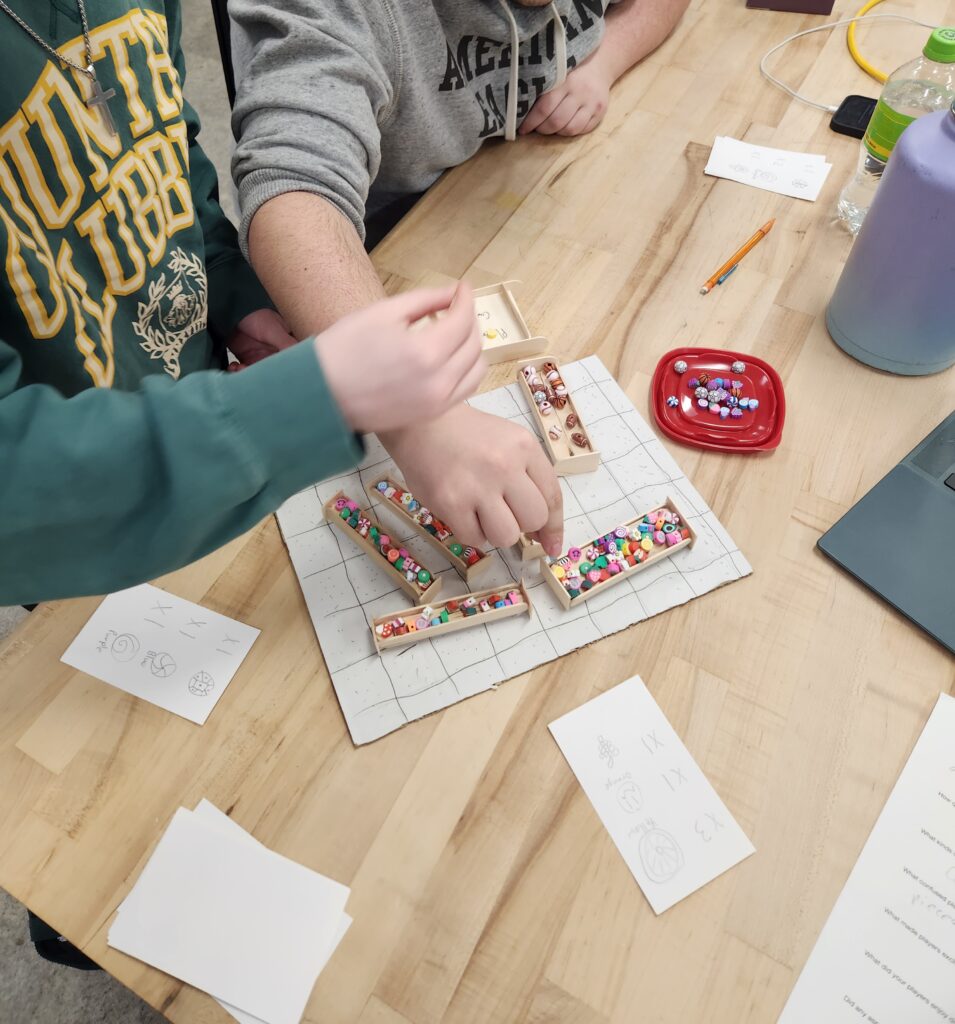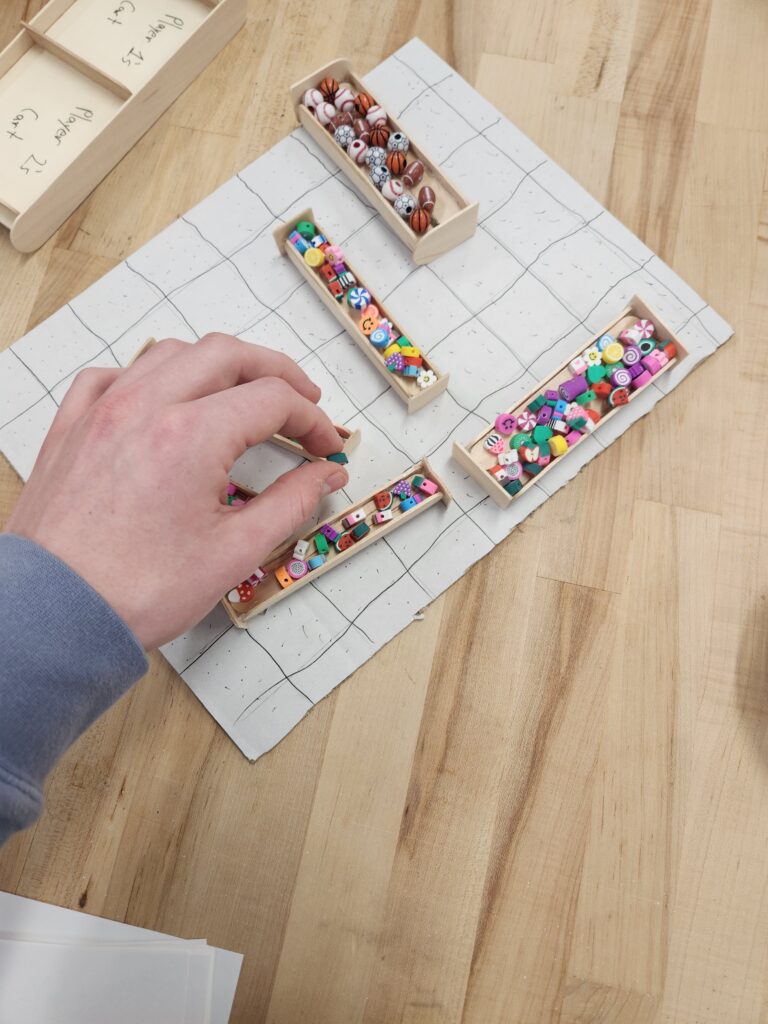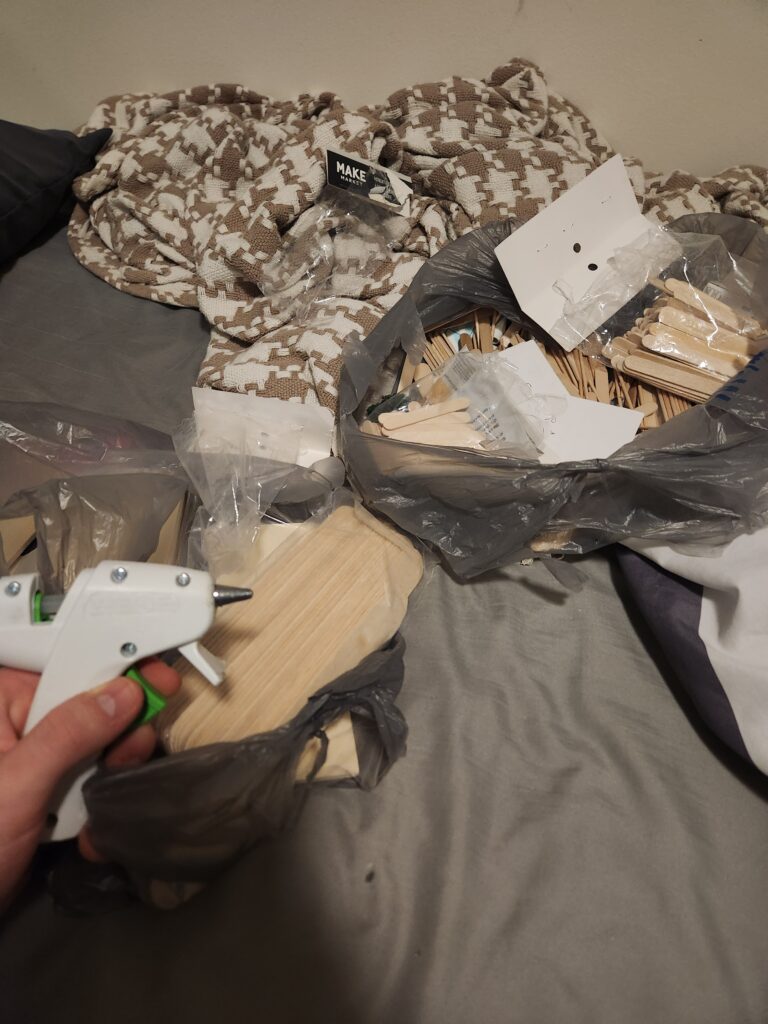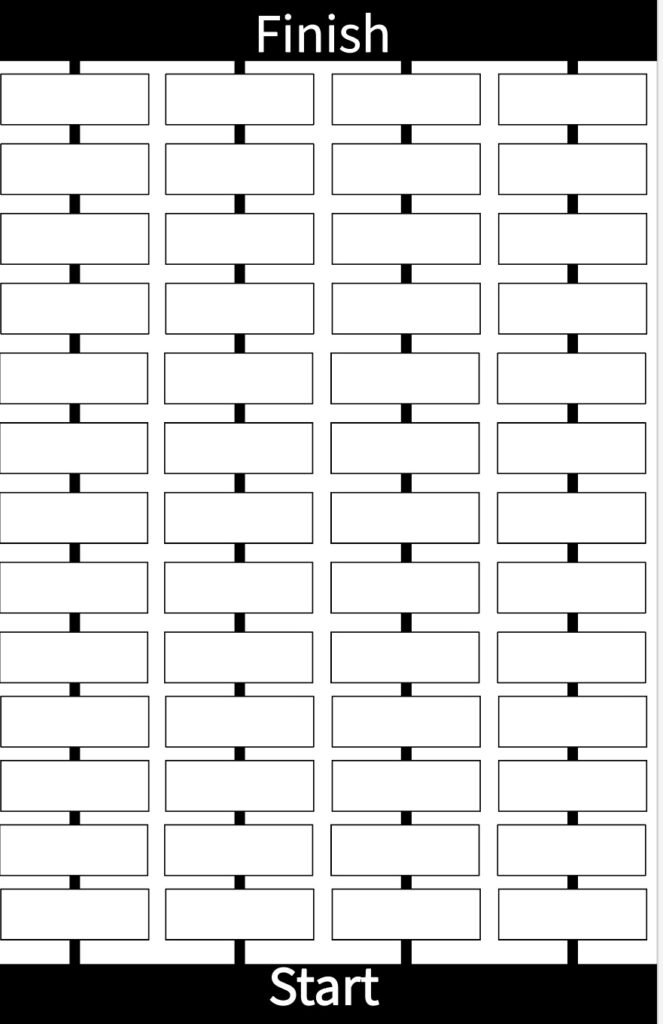My prototype I am working on is a drinking game. Not 100% sure if I am allowed to do this or not but its been a blast making it so far. Obviously I can not play test this in class, so next week when my friends come up I will let them play it and give me their opinions. The main reason I decided to do this though is that I love whenever I can sit down with my best friends and play a game like this. The goal obviously is to drink but I also put more heartwarming cards in it so maybe every now and then you can get a compliment or two. I think this will be an iteration of the game Kings Cup. Whatever the case I’ll post an update whenever this is finished.
5 Ideas for Simulation Games
- Student Simulation Game
Go through a college campus of your choice. Pick from being the star QB to a frat brother on the coolest frat. Go around college life how you see fit for your choice.
2. Celeb Simulation
Be any celeb of your choosing and live in his or her shoes and see if you can keep up with their busy lifestyle
3. Judge Simulation
You are the best judge for a bunch of high profile cases. Whose side are you gonna take? And how is that going to affect the world in the long run.
4. Presidential Simulation
You are the president of the United Crates. You will be presented with very intense situations. How will you deal with them. Will you keep the Crates safe of will you start another World War with Crusha.
5. Mob Boss Simulation
You are the mob boss of the biggest mob in NYC. Try to stay away from the police. Deal with the mob and the business while trying to raise a young impressionable daughter.
Week 3 Game played
I played Dumb Ways To Die, to be honest I played this a lot growing up with my friends because we thought it was really funny. The main thing is that we played each other to see who would get the best score. Does make you feel bad or wonder what its like to be in their shoes. Other than that its a fun little game to play.
Week 3
Day in your shoes: Players live a day in the life of an other player. Goal is to feel empathetic for other player.
Silent Conversations: Players communicate through body language. Game revolves around a social challenge.
Helping Hand: Help the player throughout their day. Goal is to show kindness.
Perspective Shift: Players must solve problem based on the certain character. Game highlights the point of viewing multiple viewpoints.
Letter to a Friend: Gift a letter to any of your friends. Game shows how human show empathy and emotional connection.
Week 2
Debate Simulator: Game that requires you to persuade the npc on changing their opinions for the election.
Empathy Experience: Tell life stories and get a different reaction from other people. Goal is to change players perspective on stories.
Mind Benda: A game that challenges their understanding of reality. Requires players to think outside normal patterns.
Identity Crisis: Player can shapeshift into different forms, goal is to find out why the player transformed into that shape.
Echoes: Normal story game but as the game goes on the choices you made keep stacking and stacking ubtil the game is almost unbeatable
Discussion: Doctrine – Cognitive Task Analysis, Full Spectrum Warrior, and Medical Simulation
Cognitive Task Analysis (CTA) is a method used to break down complex tasks into smaller cognitive steps, helping individuals learn and apply skills more effectively.
Full Spectrum Warrior is a military training simulation disguised as a video game, developed to teach soldiers tactical decision-making under pressure.
Medical Simulations use virtual or physical environments to train medical professionals in procedures, crisis management, and decision-making. These simulations allow learners to practice without real-world consequences, reinforcing procedural memory and critical thinking under pressure.
Full Spectrum Warrior is a military training simulation disguised as a video game, developed to teach soldiers tactical decision-making under pressure.
Medical Simulations use virtual or physical environments to train medical professionals in procedures, crisis management, and decision-making.
What are the challenges a team faces when working on an educational game?
Balancing fun, education, and accuracy is difficult. Game designers want engaging mechanics, while pedagogy experts focus on structured learning
Vetoed Game Ideas and Issues of Scientists, Pedagogy Experts, and Designers: Scientists worried about oversimplification and misinformation. Pedagogy experts focused on aligning the game with learning objectives. Designers feared that too much educational content would make the game boring.
What the Team Learned from Playtesting Their Prototypes
Playtesting showed how players interacted with the game
How Playtesting Resolves Conflicts Among Team Members: Playtesting provides real user data instead of opinions. It helps team members see what actually engages and educates players. This shifts discussions from personal preferences to objective improvements.
Simulation Game Ideas
Simulation games
- No before you go driving simulator – This would be a driving simulator for people who have driving anxiety and it could help them practice routes that they may need to drive so that they are already familiar with the roads and the surroundings and any interesting traffic situations. The game would not include any crashes or really any consequences because I want the driving experience to be presented in a way where it is not this scary terrifying thing where you feel like you’re going to die. I think there also could be a mode where you can practice certain situations and other things. For instance, one situation could be what do you do when you get pulled over by a cop or what do you do if there is an ambulance coming or your windows fog up. For a little more context, I have experienced driving anxiety and I often study and try to memorize my routes before I even take them on Google Maps and Streetview. This would help people like myself and even first time drivers. To gear the game even more towards anxiety, I think the game could include tips to help reduce anxiety while driving, especially because judgment can become impaired at a certain point.
- City Girl Simulator – This game would simulate what it’s like to be in a city alone as a woman, including the catcalling and dangerous situations that a lot of women unfortunately experience. This would be mostly for men to emphasize with women.
- Get a Job – A simulation about the process of trying to get hired as a minority (especially relevant now)
- Overstimulation Simulator. simulating what its like to be overstimulated in different situations to show people what its like who don’t really experience that feeling as much as other people.
- Food allergen simulator. people would try to live like they have specific food allergies and dietary restrictions to see what other people go through, especially those who have celiac disease and may need to worry about food cross contamination. This could be something that is playtested irl.
Other game ideas
- Garden Sabotage from last semester but it’s with a native plants and flowers and invasive bugs to teach people about the importance of biodiversity and maintaining a good native plant garden and why invasive bugs are bad
- State park conservation game this is similar to my National Park game idea but It would focus on more local parts even though those aren’t going through a lot of stuff right now with laws but it would teach people the importance of maintaining them and what they’re good for and it would get people to know about some of the different outdoor spaces that are in Pennsylvania and in particularly the side of the state and I think it would be effective because it would present some more local effects as even national effects can feel really distant from people
- Turning my mural into a game of hide experience where people can learn about the stuff that I’ve studied with myspace and a can show the benefits of trees it can show how art can be a powerful tool for social change and really just get people to experience my work on another level instead of seeing and reading about it
- Game about managing your emotions and daily tasks. You can only manage so much and do so many things so you have to make difficult sacrifices like do you do your homework or do you go to someone’s funeral it’s the really difficult decisions whenever you have a busy life and you are a college student and you have a lot going on
- A 2 player or 2 team game about one side being the government the tries to surprise the general public’s protests and revolts and tries to stop it from reaching mainstream media and the general public just wants their causes to be heard they want to be seen and they want change to be made so it’s just a battle between these 2 opposing forces
- we all make mistakes – party game where you share something you’re ashamed of, embarrassed about and regret. leads to an open discussion that its okay to make mistakes.
Playtest for Reese – Faction Fun
- What was the most frustrating moment or aspect of what you just played? Just learning all of the specifics with the rules. The concept wasn’t hard to grasp but there were a lot of little exceptions in the rules that made it difficult to not have to constantly refer to. The game was really well put together though.
- What was your favorite moment or aspect of what you just played? I loved the 3D printed pieces and tiles. The game looked and felt really put together.
- Was there anything you wanted to do that you couldn’t? I kind of wanted the first connecting settlement to the original settlement to allow me to get a new pawn because it just made more sense to me that way. I also wanted the mountains to be worth trying to conquer, but they were just too hard to roll for.
- If you had a magic wand to wave, and you could change, add, or remove anything from the experience, what would it be? I think just simplifying it to make the game more easy to understand off the bat. I think that placemats/reference cards could help with that.
- What should be improved with the next version? I think more cards could potentially be added, but mostly just simplification of some of the rules to make it easier for first time players to understand.
- What was the game’s message? The game was about colonization vs native peoples. I feel like it was a commentary on colonizers taking over natural land and indigenous settlements and the game could have leaned into that even more.
Describe the game in 3 words. Strategic, thoughtful, interesting
Evelyn: Simulation Game Ideas
- Elderly Simulator: a VR simulation experience to build empathy for the experience of the elderly. Movements and actions would be altered to resemble the reality of their situation.
- Civil Engineering Simulator: build bridges, roads, and other constructions and see the simulated effects on the environment and community. Experiment and alter traffic signs to better regulate traffic flow.
- Detective Investigation Simulator: see the clues, solve the crime. the game simulates the experience of investigators. Investigate the crime scene, interrogate witnesses, and do outside research to solve the crimes.
- History Time Travel Game: travel through history in VR and experience that time period. Perhaps players could be sent to a time period and observe happenings to answer trivia questions.
- Hurricane Relief Simulator: See the immediate effects of a hurricane on both the social wellbeing and physical state of the community. Help initiate recovery and rebuild the communities with proactive measures to prevent further destruction.
Sara Estus – Simulation Game Reviews
Full Spectrum Warrior: As a person who doesn’t play shooter games, I think for its time, FSW is a really interesting and involved way to resolve a need for team cooperation and basic army tasks, such as how they move from different spaces and focus on the whole teams lives, rather than the comparison of (at least what I know) about games like Call of Duty, where it’s every man for himself. Giving a whole review on graphics and implications seems a bit unfair due to the judgment of time and what we have in terms of quality today. However, for 2004, the graphics and mechanics are top tier. I hope those who were made to play it enjoyed the experience, even though a realistic game about war isn’t exactly what I would consider fun.
SIMULATION GAMES: (Personal)
Stardew Valley: Though many wouldn’t first consider Stardew Valley to be a simulation game, this game has a super special place in my literal SOUL. I can NOT recommend this game enough for anyone, because it just brings so much comfort and joy in a way games like Animal Crossing and Sims could otherwise not. To explain the game briefly, players begin the game as a worker in a corporate office job, they are feeling really dissatisfied with life and want to experience something more. SO (skipping a lot of details) players inherit their grandfather’s farm and must begin bringing life back to what the farm once was. This game goes on luck, income, spending, and other factors like farming, fishing, mining, and combat. It is a really sweet game, and a lot of hardcore fans will go into depth on how to play and what to do, but really the game just takes a little googling, and some relaxing!
Surgeon Simulator: I think for many of us, this was our first experience with a straightforward “Simulation Game” as many Youtubers at the time tried the game out, long before many of us could play it. The game wasn’t so much focused on being a “perfect surgeon” but more a humorous view on how poorly things can go so quickly.
Overconsumption Draft 1
Sara Estus – 5 Simulation Game Ideas
- VR Life improvement game, In this game, users will be able to go through a series of books that touch on various topics that some may not have the chance to learn, such as changing a car tire, tying a tie, and basic first aid, as well as how to make (various foods) This VR gives the idea of “hands on” without needing to rely on the help and coaching of others. The books allow users to choose from various tasks based on their personal goals, and then the “game” begins by putting users in a virtual setting where they will begin. Think of it as Duolingo, and Cooking Mama, but you don’t deal with a pesky bird, and no mom will be disappointed in you for messing up!
- Plant Meditation, This VR game essentially allows the player to become a plant in simulation. They get to choose what plant they are, what color pot they are in, and a general location in the world, as well as the time of day and season. This game uses sensors to track heart rate and breathing and will give players the ability to unwind and meditate. The goal of the simulation is to have calm breathing, thoughts, and be still, once users match this state, their plant will slowly grow, begin to flower, and thrive.
- To be with Fauna, This VR game allows players to experience forests and nature through the eyes of various animals. There is no solid goal in this game other than to walk around, see the sights and observe different animals and plants. Players can also switch between animals to get unique views, like going from a black bear to a hawk.
- Depression Nap, this game creates a simulation of what it can be like living with extreme depression. The player starts the game by waking up in a dimly lit room that is almost completely trashed. Throughout the game, players will slowly get achievements by cleaning the room, reaching out to friends, and generally trying to get life for the character back in order.
- A walk-through life, this is a collaborative game where various people will essentially record a day in their life and allow users to experience a different life, culture, and situation through the eyes of others. Think of this as a playable “A Day in the life” video. There can also be a feature where multiple choices are made so players have a more choice based experience depending on what interests them.
game reviews
overconsumption
- the most frustrating part of this game was moving. a lot of the cards were for moving backwards so it was hard to move forward.
- i loved the dialogue that was spurred from the reflecting parts of the cards.
- i wanted to be able to move more, we ended up with a lot of move backwards cards so we didn’t end up really moving off of start.
- i feel like the game would work better if you would start in the middle of the board. this would make it more like seeing your real impact and you would just go through all the cards.
- i feel the board need more stuff maybe colors more specific branding.
- the purpose was for people to speak and think critically about how people use things in the world and how it can affect our consumption.
- simple, informative, thoughtful
keep talking and nobody explodes
this game is very fun simulation of defusing a bomb. it works a lot with blind teamwork. one person ha the manual and one person has the bomb. they can not see each others objects forcing them to describe and decipher colors symbols and actions through nothing but speech.
Mother’s Wish Rules + Analysis
Making Process Pictures + Gameplay





Game Maker’s Play Test Notes
- What questions did your players have?
- Some common questions that the players had were based on the rules, such as “What if you pick up and put back items?” or “Can I take from the other player’s bin?” Any of the questions were based on unspecifications that I will have to clarify in the rules, in order to prevent people from doing the wrong actions. Another question was “Am I allowed to block the other player?”
- How quickly did they learn to play?
- It didn’t take long for the players to catch on to the ruleset. I’d say that this game has one of the easier rulesets I’ve made but nonetheless needs improvement. The players were able to play the game and adapt, but they still ran into complications that I will have to personally look over.
- What kinds of interactions did the players have?
- This is a very competitive game, and the players were constantly at each other’s throat. From a direct interaction, the players clash tweezers and wrestle with pieces time to time, as well as striving to the first to earn points. However, not much talking is involved in the game, as players are dialed in to focus on what pieces to grab.
- What confused players?
- Players were less confused about the rules, and more confused about the pieces they had to grab. I’ve noticed that in the prototype, I did not do a good job of indicating what type of pieces they have to lookout for. This confused the players, as they sometimes grabbed the wrong pieces or mistakened items for something else.
- What made players excited?
- The excitement mainly derived from the bulk of the gameplay, where players were rushing to earn points. When the points were earned, it was rewarding to the players too, complimenting their quick-thinking and observation skills. The anticipation of the manager flipping over the card evoked excitement as well, as the players eagerly awaited their next challenge.
- What did your players enjoy doing?
- The players enjoyed using the tools (tiny tweezers and shopping carts) and competing with each other. They enjoyed navigating through the miniature store model, which gave them an environment to interact with.
- Did any aspect of the game frustrate players?
- I wouldn’t say so, but the players suggested a mechanic to make things easier for the playing experience. I think it was more about a factor that they wish was a part of the game rather than frustration. For example, they suggested a clock/bell that could be hit to indicate that they are done with the shopping list, in order to prevent frequent ties.
- What did your players learn/take away from your game? Was that what you intended?
- I’d say my players learned the aspects of keeping cool during a moment of chaos. This game really enforces the principles of maintaining composure and concentration, no matter how stressful the environment may be. This was sort of what I intended, since I was looking to create a fast-paced and competitive game.
- What is your plan to address player questions, confusion, and frustration?
- Just as I’ve tackled criticism in the past, I plan on addressing the confusion, questions and frustrations of players through communication and/or feedback. Through frequent playtesting, I expect players to tell me the things that are wrong with my game. There have been instances where I thought the game was perfect from the start, until players have exposed its flaws in rules. I’ll also have to read over the rules of my game and make extra clarifications and changes to better the playing experience.
- If your players didn’t get your intended message, what will you change?
- One thing I will point out is that this game is supposed to make the players feel empathy, as the premise of the game revolves around getting groceries for your sick mother. I don’t think the players understood that, at least I can do a better job at making that known. In order to fix this, I will add designs to the cards which will show a small picture of your mother asking for the specific groceries. This way, players will be reminded of their sick mother, making them more determined.
Potential Rule Changes/Iterations
- A needed change that I will have to make are little clarifications here and there in the rules. This includes rule changes such as:
- No stealing from the other player
- A restock session before each round by the manager
- Something to do with picking back up items and putting it back on the shelves
- No blocking players/no foul play
- Additionally, I should probably make some design changes, or rather add some things that can make the playing experience more organized. This can include:
- Redesign of the cards, making it so that players can understand which items to pick out
- More shelves, different types of shelving for more interesting playing fields
- A clock or a bell, so that the player finished with the shopping list can indicate clearly that they are finished
- Design to the cards, with the mother on the face of the cards drawn

